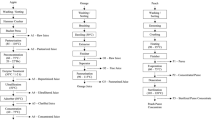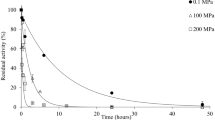Abstract
Furan, a potential carcinogenic compound, can be formed in array of processed foods. The objective of this study was to conduct kinetic studies in pineapple juice and assess the interactive effects of pressure (0.1 to 600 MPa) and temperature (30 to 120 °C) on furan formation. Additional experiments were carried out in tomato, watermelon, cantaloupe, kale, and carrot juice to understand the influence of matrix and juice pH. Furan was monitored in raw (control) and processed samples by automated headspace gas chromatography mass spectrometry, and quantified by calibration curve method with d4-furan as internal standard. The data were modeled using zero-, first-, and second-order equations. The zero-order rate constants (k T,P ), activation energy (E a ), and Gibbs free energy of activation (ΔG ‡) of furan formation in thermally processed (TP; 90–120 °C) pineapple juice were found to be 0.036–0.55 μg/kg/min, 98–114 kJ/mol, and 173.9–180.5 kJ/mol, respectively. Furan concentration was negligible and close to the detection limit (0.37 μg/kg) after pressure treatment (600 MPa at 30 °C) of juice samples. For similar process temperatures, the rate constants of pressure-assisted thermally processed (PATP; 600 MPa at 105 °C) pineapple juice were lower than that of TP samples. Furan formation was influenced by juice matrix and pH. On the other hand, PATP markedly suppressed furan (0.7 to 1.6 μg/kg) in these selected juices. In conclusion, furan formation increased with process temperature and treatment time, while pressure treatment at ambient temperature did not promote its production. Furan formation in TP fruit juices was also influenced by juice matrix and pH, but these were not the significant factors for PATP-treated juices.






Similar content being viewed by others
References
Akıllıoğlu, H. G., Bahçeci, K. S., & Gökmen, V. (2015). Investigation and kinetic evaluation of furan formation in tomato paste and pulp during heating. Food Research International, 78, 224–230.
Balasubramaniam, V. M., Martínez-Monteagudo, S. I., & Gupta, R. (2015). Principles and application of high pressure-based technologies in the food industry. Annual Review of Food Science and Technology, 6, 435–462.
Belitz, H. D., Grosch, W., & Schieberle, P. (2009). Food chemistry, 4th revised and extended edn. Berlin: Springer.
Bermúdez-Aguirre, D., Corradini, M. G., Candoğan, K., & Barbosa-Cánovas, G. V. (2016). High pressure processing in combination with high temperature and other preservation factors. In V. M. Balasubramaniam, G. V. Barbosa-Cánovas, & H. L. Lelieveld (Eds.), High pressure processing of food (pp. 193–215). New York: Springer.
Boekel, M. A. J. S. (1996). Statistical aspects of kinetic modeling for food science problems. Journal of Food Science, 61(3), 477–486.
Bristow, M., & Isaacs, N. S. (1999). The effect of high pressure on the formation of volatile products in a model Maillard reaction. Journal of the Chemical Society, Perkin Transactions, 2(10), 2213–2218.
Buckow, R., Kastell, A., Terefe, N. S., & Versteeg, C. (2010). Pressure and temperature effects on degradation kinetics and storage stability of total anthocyanins in blueberry juice. Journal of Agricultural and Food Chemistry, 58(18), 10076–10084.
Bule, M. V., Desai, K. M., Parisi, B., Parulekar, S. J., Slade, P., Singhal, R. S., & Rodriguez, A. (2010). Furan formation during UV-treatment of fruit juices. Food Chemistry, 122(4), 937–942.
Chakraborty, S., Rao, P. S., & Mishra, H. N. (2015). Effect of combined high pressure–temperature treatments on color and nutritional quality attributes of pineapple (Ananas comosus L.) puree. Innovative Food Science & Emerging Technologies, 28, 10–21.
Crews, C., & Castle, L. (2007). A review of the occurrence, formation and analysis of furan in heat-processed foods. Trends in Food Science & Technology, 18(7), 365–372.
Daryaei, H., Yousef, A. E., & Balasubramaniam, V. M. (2016). Microbiological aspects of highpressure processing of food: inactivation of microbial vegetative cells and spores. In V. M. Balasubramaniam, G. V. Barbosa-Canovas, & H. Lelieveld (Eds.), High pressure processing of food (pp. 271–294). New York: Springer.
Duan, H., & Barringer, S. A. (2012). Changes in furan and other volatile compounds in sliced carrot during air-drying. Journal of Food Processing and Preservation, 36(1), 46–54.
Fan, X. (2005). Formation of furan from carbohydrates and ascorbic acid following exposure to ionizing radiation and thermal processing. Journal of Agricultural and Food Chemistry, 53(20), 7826–7831.
FDA, U.S. Food and Drug Administration. (2004). Determination of furan in foods. Updated October 7, 2006. Retrieved from http://www.fda.gov/Food/FoodborneIllnessContaminants/ChemicalContaminants/ucm078400.htm (date accessed September 21, 2014).
FDA, U.S. Food and Drug Administration. (2009). Exploratory data on furan in food: individual food products. Retrieved from http://www.fda.gov/Food/FoodborneIllnessContaminants/ChemicalContaminants/ucm078439.htm (date accessed May 16, 2015).
FDA, U.S. Food and Drug Administration. (2015). Kinetics of microbial inactivation for alternative food processing technologies—overarching principles: kinetics and pathogens of concern for all technologies. Retrieved from http://www.fda.gov/food/foodscienceresearch/safepracticesforfoodprocesses/ucm100198.htm (date accessed July 10, 2016).
Galeb, A. D., Wrolstad, R. E., & M.I.N.A, M. D. (2002). Composition and quality of clarified cantaloupe juice concentrate. Journal of Food Processing and Preservation, 26(1), 39–56.
Gupta, R., Kopec, R. E., Schwartz, S. J., & Balasubramaniam, V. M. (2011a). Combined pressure-temperature effects on carotenoid retention and bioaccessibility in tomato juice. Journal of Agricultural and Food Chemistry, 59(14), 7808–7817.
Gupta, R., Mikhaylenko, G., Balasubramaniam, V. M., & Tang, J. (2011b). Combined pressure–temperature effects on the chemical marker (4-hydroxy-5-methyl-3 (2H)-furanone) formation in whey protein gels. LWT-Food Science and Technology, 44(10), 2141–2146.
Heldman, D. R. (2013). Food preservation process design (pp. 489–497). US: Springer.
Huang, X., & Barringer, S. A. (2016). Kinetics of furan formation during pasteurization of soy sauce. LWT-Food Science and Technology, 67, 200–205.
Huang, X., Duan, H., & Barringer, S. A. (2011). Effects of buffer and temperature on formation of furan, acetic acid and formic acid from carbohydrate model systems. LWT-Food Science and Technology, 44(8), 1761–1765.
International Agency for Research on Cancer (1995). IARC monographs on the evaluation of carcinogenic risks to humans: dry cleaning, some chlorinated solvents and other industrial chemicals (Vol. 63, pp. 393–407). Lyon, France.
Luechapattanaporn, K., Wang, Y., Wang, J., Al-Holy, M., Kang, D. H., Tang, J., & Hallberg, L. M. (2004). Microbial safety in radio-frequency processing of packaged foods. Journal of Food Science, 69(7), 201–206.
Maga, J. A., & Katz, I. (1979). Furans in foods. Critical Reviews in Food Science & Nutrition, 11(4), 355–400.
Nguyen, L. T., Tay, A., Balasubramaniam, V. M., Legan, J. D., Turek, E. J., & Gupta, R. (2010). Evaluating the impact of thermal and pressure treatment in preserving textural quality of selected foods. LWT-Food Science and Technology, 43(3), 525–534.
Nguyen, L. T., Balasubramaniam, V. M., & Ratphitagsanti, W. (2014). Estimation of accumulated lethality under pressure-assisted thermal processing. Food and Bioprocess Technology, 7(3), 633–644.
NTP, National Toxicology Program. (2011). Furan CAS no. 110-00-9. Report on Carcinogens, 12 ed. <http://ntp.niehs.nih.gov/ntp/roc/twelfth/profiles/Furan.pdf> (date accessed Oct 29, 2015).
Owczarek-Fendor, A., De Meulenaer, B., Scholl, G., Adams, A., Van Lancker, F., Yogendrarajah, P., & De Kimpe, N. (2010). Furan formation from vitamin C in a starch-based model system: influence of the reaction conditions. Food Chemistry, 121(4), 1163–1170.
Palmers, S., Grauwet, T., Kebede, B. T., Hendrickx, M. E., & Van Loey, A. (2014). Reduction of furan formation by high-pressure high-temperature treatment of individual vegetable purées. Food and Bioprocess Technology, 7(9), 2679–2693.
Palmers, S., Grauwet, T., Celus, M., Kebede, B. T., Hendrickx, M. E., & Van Loey, A. (2015). Furan formation as a function of pressure, temperature and time conditions in spinach purée. LWT-Food Science and Technology, 64(2), 565–570.
Palmers, S., Grauwet, T., Vanden Avenne, L., Verhaeghe, T., Kebede, B. T., Hendrickx, M. E., & Van Loey, A. (2016). Effect of oxygen availability and pH on the furan concentration formed during thermal preservation of plant-based foods. Food Additives & Contaminants: Part A 33(4), 612–622.
Patazca, E., Koutchma, T., & Balasubramaniam, V. M. (2007). Quasi-adiabatic temperature increase during high pressure processing of selected foods. Journal of Food Engineering, 80(1), 199–205.
Pekař, M. (2007). Affinity and reaction rates: reconsideration of experimental data. Helvetica Chimica Acta, 90(10), 1897–1916.
Perez Locas, C., & Yaylayan, V. A. (2004). Origin and mechanistic pathways of formation of the parent furan—a food toxicant. Journal of Agricultural and Food Chemistry, 52(22), 6830–6836.
Rajan, S., Ahn, J., Balasubramaniam, V. M., & Yousef, A. E. (2006). Combined pressure-thermal inactivation kinetics of Bacillus amyloliquefaciens spores in egg patty mince. Journal of Food Protection, 69(4), 853–860.
Rasanayagam, V., Balasubramaniam, V. M., Ting, E., Sizer, C. E., Bush, C., & Anderson, C. (2003). Compression heating of selected fatty food materials during high-pressure processing. Journal of Food Science, 68(1), 254–259.
Rastogi, N. K., Raghavarao, K. S. M. S., Balasubramaniam, V. M., Niranjan, K., & Knorr, D. (2007). Opportunities and challenges in high pressure processing of foods. Critical Reviews in Food Science and Nutrition, 47(1), 69–112.
Sevenich, R., Kleinstueck, E., Crews, C., Anderson, W., Pye, C., Riddellova, K., Hradecky, J., Moravcova, E., Reineke, K., & Knorr, D. (2014). High-pressure thermal sterilization: food safety and food quality of baby food puree. Journal of Food Science, 79(2), M230–M237.
Sevenich, R., Bark, F., Kleinstueck, E., Crews, C., Pye, C., Hradecky, J., Reineke, K., Lavilla, M., Martinez-de-Maranon, I., Briand, J., & Knorr, D. (2015). The impact of high pressure thermal sterilization on the microbiological stability and formation of food processing contaminants in selected fish systems and baby food puree at pilot scale. Food Control, 50, 539–547.
Silva, F. V., & Gibbs, P. (2004). Target selection in designing pasteurization processes for shelf-stable high-acid fruit products. Critical Reviews in Food Science and Nutrition, 44(5), 353–360.
Van Boekel, M. A. (2008). Kinetic modeling of food quality: a critical review. Comprehensive Reviews in Food Science and Food Safety, 7(1), 144–158.
Vazquez-Landaverde, P. A., Qian, M. C., & Torres, J. A. (2007). Kinetic analysis of volatile formation in milk subjected to pressure-assisted thermal treatments. Journal of Food Science, 72(7), E389–E398.
Yaylayan, V. A. (2006). Precursors, formation and determination of furan in food. Journal für Verbraucherschutz und Lebensmittelsicherheit, 1(1), 5–9.
Zoller, O., Sager, F., & Reinhard, H. (2007). Furan in food: headspace method and product survey. Food Additives and Contaminants, 24(sup1), 91–107.
Acknowledgements
Research support to The Ohio State University Food Safety Engineering Laboratory (u.osu.edu/foodsafetyeng/) was provided, in part, by USDA National Institute for Food and Agriculture HATCH project OHO01323 and the food industry. Authors are grateful to the OSU Center for Applied Plant Sciences Targeted Metabolomics Laboratory (metabolomics.osu.edu) for access to the GC-MS equipment. References to commercial products or trade names are made with the understanding that no endorsement or discrimination by The Ohio State University is implied.
Author information
Authors and Affiliations
Corresponding author
Rights and permissions
About this article
Cite this article
Dhakal, S., Balasubramaniam, V.M., Cocuron, JC. et al. Pressure-Thermal Kinetics of Furan Formation in Selected Fruit and Vegetable Juices. Food Bioprocess Technol 10, 1959–1969 (2017). https://doi.org/10.1007/s11947-017-1950-z
Received:
Accepted:
Published:
Issue Date:
DOI: https://doi.org/10.1007/s11947-017-1950-z




